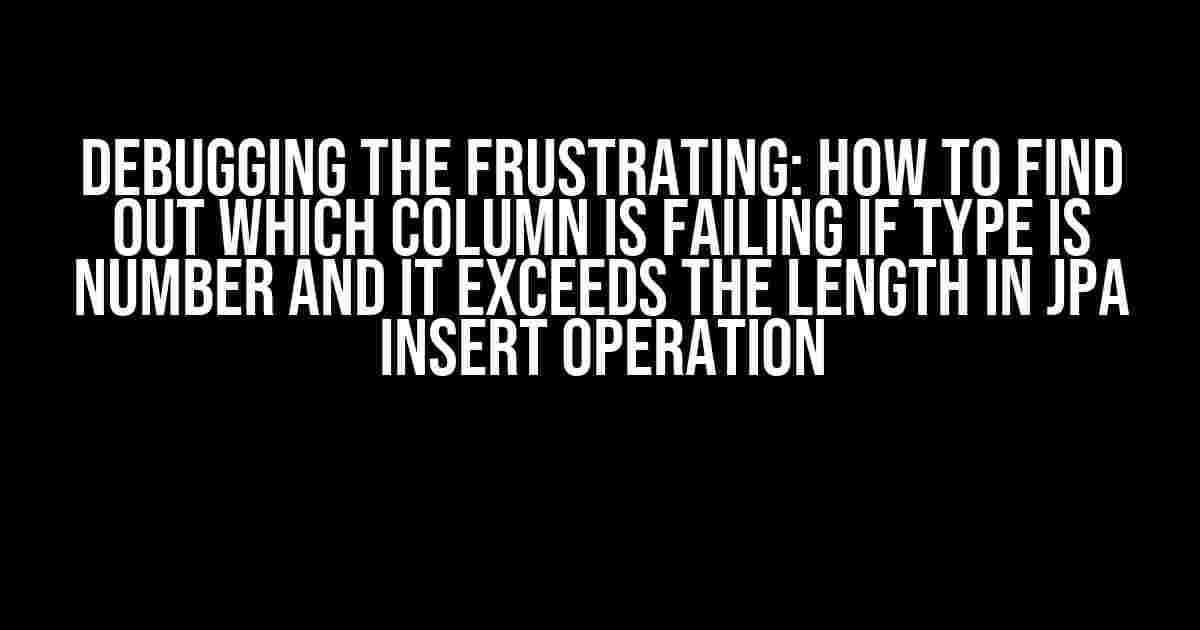Have you ever faced the frustrating error “Data truncation: Data too long for column” while performing a JPA insert operation? Well, you’re not alone! It can be a daunting task to identify which column is causing the issue, especially when dealing with numerical data types. In this article, we’ll guide you through a step-by-step process to debug and resolve this common problem.
Understanding the Error
The “Data truncation: Data too long for column” error occurs when the data being inserted into a column exceeds its defined length. This error can be misleading, as it doesn’t provide any information about the specific column causing the issue. When dealing with numerical data types, it’s even more challenging to identify the culprit column.
Why Does This Error Occur?
There are several reasons why this error might occur:
- Inadequate column length definition: If the column is defined with a length that’s too short to accommodate the data being inserted, this error will occur.
- Incorrect data type usage: Using an incorrect data type for a column can lead to this error. For example, using a
NUMERICtype for a column that requires aDECIMALtype. - Data overflow: When the data being inserted exceeds the maximum length or precision defined for the column, this error will occur.
Step-by-Step Debugging Process
Now that we’ve understood the error, let’s dive into the step-by-step process to identify the column causing the issue:
Step 1: Review the JPA Entity
Start by reviewing your JPA entity that’s being used for the insert operation. Look for any columns with numerical data types, such as Integer, Long, or Double.
@Entity
public class MyEntity {
@Id
@GeneratedValue(strategy = GenerationType.IDENTITY)
private Integer id;
@Column(length = 10)
private Integer phoneNumber;
@Column(precision = 10, scale = 2)
private Double amount;
// getters and setters
}
Step 2: Check the Database Table Structure
Verify the database table structure to ensure that the column lengths and data types match the JPA entity definitions. You can use a database client tool like MySQL Workbench, pgAdmin, or SQL Server Management Studio to access your database.
| Column Name | Data Type | Length/Precision |
|---|---|---|
| id | INT | 11 |
| phone_number | VARCHAR | 10 |
| amount | DECIMAL | 10, 2 |
Step 3: Enable SQL Logging
Enable SQL logging in your JPA provider to capture the SQL statement being executed during the insert operation. This will help you identify the exact column causing the issue.
// Hibernate example .properties: hibernate.show_sql=true hibernate.format_sql=true // EclipseLink example .properties: eclipselink.logging.level=FINEST
Step 4: Analyze the SQL Statement
Analyze the captured SQL statement to identify the column that’s causing the error. Look for any columns with numerical data types and inspect their values.
INSERT INTO my_table (id, phone_number, amount) VALUES (NULL, '1234567890', 12345.6789)
Step 5: Verify Data Length and Precision
Verify the length and precision of the numerical data being inserted against the column definitions. Check if the data exceeds the defined length or precision.
phone_number: '1234567890' (length: 10) amount: 12345.6789 (precision: 10, scale: 2)
Common Solutions
Based on your analysis, you may need to apply one or more of the following solutions:
Solution 1: Increase Column Length
If the data length exceeds the defined column length, consider increasing the column length to accommodate the data.
@Column(length = 15) private String phoneNumber;
Solution 2: Adjust Data Type
If the data type is incorrect, adjust the data type to match the requirements. For example, if the column requires a decimal data type, use BigDecimal instead of Double.
@Column(precision = 10, scale = 2) private BigDecimal amount;
Solution 3: Truncate or Round Data
If the data exceeds the defined length or precision, consider truncating or rounding the data to fit within the defined constraints.
@Column(precision = 10, scale = 2) private BigDecimal amount; // truncate data to 2 decimal places amount = amount.setScale(2, RoundingMode.DOWN);
Conclusion
In this article, we’ve walked you through a step-by-step process to debug and resolve the “Data truncation: Data too long for column” error when dealing with numerical data types in JPA insert operations. By following these instructions, you’ll be able to identify the column causing the issue and apply the appropriate solution to resolve the problem.
Remember to review your JPA entity, database table structure, and SQL logging to identify the root cause of the error. Adjust your column definitions, data types, or data truncation/rounding as needed to ensure successful insert operations.
Happy debugging!
Frequently Asked Question
Are you tired of dealing with JPA insert operations that fail due to exceeded column length? Look no further! Here are the top 5 questions and answers to help you identify which column is failing and how to fix it.
Q1: What is the most common error message I’ll encounter when a column exceeds its length in a JPA insert operation?
A1: The most common error message you’ll encounter is “Data truncated for column ‘column_name’ in table ‘table_name'”. This error message indicates that the data being inserted exceeds the maximum length allowed for that column.
Q2: How can I identify which column is causing the error if I have multiple columns with the same data type?
A2: You can enable SQL logging in your JPA provider to see the actual SQL query being executed. This will help you identify which column is causing the error. For example, in Hibernate, you can set the property “hibernate.show_sql” to “true” in your configuration file.
Q3: What are some common reasons why a column might exceed its length?
A3: Some common reasons why a column might exceed its length include: not specifying the correct length for the column, inserting data that is larger than the column’s maximum length, or using a data type that is too small for the data being inserted.
Q4: How can I prevent columns from exceeding their length in the future?
A4: You can prevent columns from exceeding their length by specifying the correct length for the column, using a data type that is large enough to accommodate the data being inserted, and performing validation checks on the data before inserting it into the database.
Q5: What is the best practice for handling errors when a column exceeds its length?
A5: The best practice for handling errors when a column exceeds its length is to catch and log the error, then provide a user-friendly error message to the user. You should also consider implementing data validation and input checking to prevent such errors from occurring in the first place.





